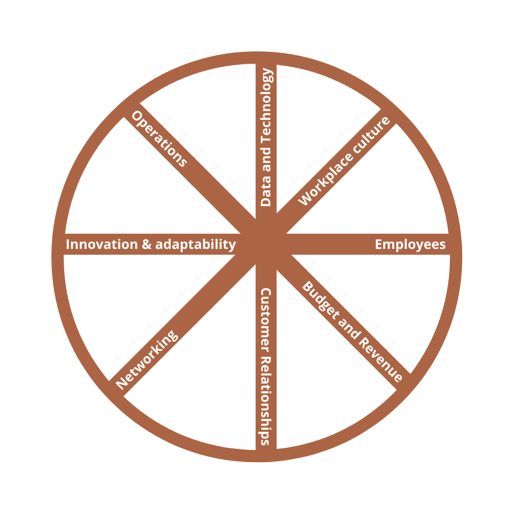Keep your wheel rolling: what sales and marketing can learn from the Wheel of Life model
When we reflect on our sales and marketing work and assess areas of strength and areas for improvement, it’s hard to know where to start or what benchmarks to refer to. Often, we slip into stream-of-consciousness thinking where one idea leads to the next until we have little direction and even fewer action items as a result.
The Wheel of Life
So how can we drill down to the core issues so we can make beneficial changes?
The wheel of life concept, is often used in personal coaching settings, discussed by Zig Ziglar, Dave Ramsey, and many others. While it’s not commonly used as a business tool, it’s one way to add structure to reflection and find balance.
The basic model looks like a wagon wheel. Mark the center point of a circle, then draw the spokes out to the edges. Each spoke represents an area of life, typically: career, finances, spirituality, physical health, intellectual growth, family relationships, social life. Some models frame these broad categories as the roles a person carries out in life, such as employee, parent, friend, etc.
It’s pretty easy to see the analogy to a rolling wheel. As long as the spokes are about the same length, a wheel rolls easily. So as long as we’re putting effort into keeping the areas of our life in balance, we thrive and become well-rounded (pun intended!).
But if we neglect one or more spokes, we risk having a lopsided wheel, and it becomes much harder to roll through life efficiently. We might even get stuck.
Measure Your Spokes
By adapting the wheel of life to our sales and marketing work, we have a framework for finding areas that are out of balance, neglected, or simply inefficient. Use our suggested “spokes” below or come up with your own:

Ask yourself if any of these areas seem more well-developed in than others. Maybe you have a great new product line poised to make a big impact in your market, but you don’t have enough staff for intensive prospecting and lead nurturing. Or maybe your sales reps waste hours sifting through inaccurate data. Or maybe you miss sales targets because you’re not using the right metrics to set actionable goals. Each of these can turn smooth rolling into lurching and clunking.
If you’ve struggled with assessing the state of your sales and marketing operations, consider giving the wheel of business model a spin. It’s a great way to identify the places you’re already doing well and those that need a little more attention. The end result is more productivity with less effort because all the spokes are equal length and the wheel is rolling efficiently. Sound good? Contact us to talk about your wheel today!
Comments